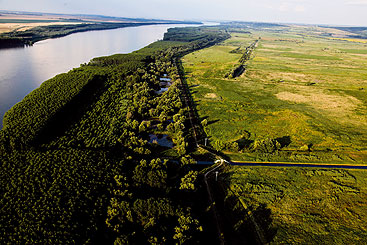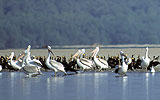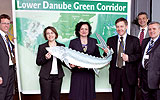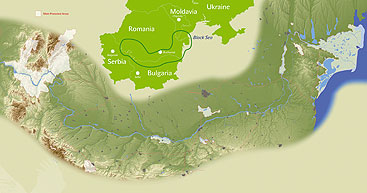Ten years of the Green Corridor

Ten years of the Green Corridor
The Lower Danube is one of the last free-flowing stretches of river in Europe, and for the last ten years it has been the site of the most ambitions wetlands protection project in Europe – with some outstanding results.

Kalimok Marsh, Bulgaria. This Danube River Basin marsh has been reconnected with the river, creating spawning places in the once cut off wetlands.
a decade after four governments agreed to work together to establish a ‘green corridor’ along the entire length of the lower danube River, europe’s most ambitious wetland protection and restoration programme is well ahead of targets for creating protected areas.
The Lower Danube Green Corridor Declaration, signed by environment ministers of Bulgaria, Romania, Ukraine and Moldova in 2000, pledged to boost protection for 775,000 ha of existing protected areas and bring another 160,000 ha under protection along the river’s final 1,000 kilometres.
The level of achievement however was much higher as some 1.4 million ha has been brought under protection to the benefit of some of Europe’s most outstanding wildlife, and enhancing water security, flood control and recreational opportunities for the area’s 29 million people.
Running behind target however is the task of wetlands restoration with the countries slightly more than a quarter of the way to their target of restoring 224,000 ha of former wetlands. It is calculated that over the past couple of centuries, some 80% of the Danube’s original floodplains, including important wetland areas, have been lost mostly due to drainage for agriculture and industry as well as flood prevention and navigation.

Danube Delta, pelicans and cormorants. There is more life in one acre of a healthy wetland than there is in one acre of almost any other kind of habitat: 100 fish species live in the Danube and 5000 animal species live along the river. The Danube Delta is a resting and breeding area for more than 320 bird species.
Wetlands protection and restoration key to a healthy river. “Wetlands protection and restoration is the key to a healthy river able to better deal with both droughts and floods,” said Andreas Beckman, Director of WWF’s Danube-Carpathian Programme. “Wetlands are not only cheap to maintain, but also save money and this is why we are taking steps not only to protect what remains, but actually to regain at least some of what has disappeared.”
The wide array of benefits provided by wetlands include flood and drought management through holding and slowly releasing water and water purification through filtration. Wetlands are also areas rich in resources such as fish and reeds.
€500 per hectare a year in wetland benefits. The value of the various benefits from Danube floodplains is estimated to be at least €500 per hectare a year.
But while WWF would like to see more work on wetlands restoration, Beckman said it was still appropriate to pay tribute to the protected area achievements of the four countries.
“The Lower Danube Green Corridor was and still is the most ambitious wetland protection and restoration initiative in Europe,” he said.
“We are looking forward to more ambitious targets for the next phase of developing the green corridor – and hopefully to celebrating again that the river is better protected than we had expected.”

Celebrating the 10th anniversary of the Lower Danube Green Corridor agreement at the ICPDR Ministerial Meeting in Vienna on 16 February
Ministers of the environment and their deputies from the four nations gathered in Vienna in February to celebrate the ten year anniversary of the Lower Danube Green Corridor and affirmed their commitment to continue working together to develop the corridor. The celebration was a side event at the ICPDR Ministerial Meeting where Danube countries adopted The Danube River Basin Management Plan (see article page 6).
WWF research around the world has also shown that rivers and basins functioning naturally will be those best able to cope with challenges of climate change such as more frequent and severe floods and longer and deeper dry spells.
“WWF is calling on all countries of the Danube basin to set qualitative and ambitious targets for each country for wetland protection and restoration as a cost-effective means for securing a host of essential ecosystem services including flood management, clean drinking water and better protection from climate impacts,” said Beckman.
“Let us continue giving life to the Danube, so that the Danube can continue giving life to us.”
The lower Danube Green Corridor has protected some of Europe’s most outstanding wildlife and enhanced water security, flood control and recreational opportunities for the area’s 29 million people. Fold out to see the lower Danube Green Corridor map, and highlights of the project’s achievements.
Along the lower Danube green corridor.

After squeezing through the Iron Gates gorge and dams between Serbia and Romania, the Danube flows free for 1000 kilometres through Romania, Bulgaria, Moldova and Ukraine before emptying into the Black Sea.
bulgaRIa
The most ecologically important areas along the Lower Danube Green Corridor in Bulgaria are the Islands of Belene and Kalimok Marshes. There, former floodplain forests and wetlands are being restored, reconnecting them with the river, creating rich feeding, breeding and spawning grounds for fish, flora and fauna. This has provided opportunities for fishing, and economic benefits from grasslands and wetland resources, along with the survival of the riverine floodplain forest as an ecologic benefit. These model projects are the first of their type in Bulgaria.
RoManIa
The Danube Delta is one of the world’s most important eco-regions for biodiversity. In Romania, dry and unproductive land on the major islands of Babina and Cernovca has been returned to the river. The islands have been turned into a mosaic of habitats that offer shelter and food for many animals, including rare birds and valuable fish species. The economic benefits of the restoration works (3680 ha), in terms of increased natural resources productivity (fish, reed, grasslands) and tourism, is about €140,000 per year. Progress with restoration is also moving forward on the Lower Danube islands from Calarasi to Braila.
MolDova
In Moldova, large sections of the Lower Prut River have been brought under protection and management plans are being prepared. With the support of the local community, a new management plan will be implemented at the Lake Beleu Scientific Reserve. This first attempt for an integrated management of wetlands will be expanded in the Lower Prut area as part of a Trilateral Biosphere Reserve between Moldova, Romania and Ukraine.
ukRaIne
On the Ukrainian side of the Danube Delta, authorities and NGOs are working hand in hand to develop a vision for the protection and restoration of the wetland areas – and have taken steps toward its realisation. Bulldozers have breached dikes on Tataru and Ermakov Islands, restoring natural flooding to 800 ha. This has allowed for the re-establishment of natural flooding conditions, creating rich feeding, breeding and spawning grounds for fish, flora and fauna. Today amazing rare birds, such as white-tailed eagles, pygmy cormorants and ferruginous ducks, thrive on Tataru Island, while inner lakes serve as spawning places for young fish from the Danube.





